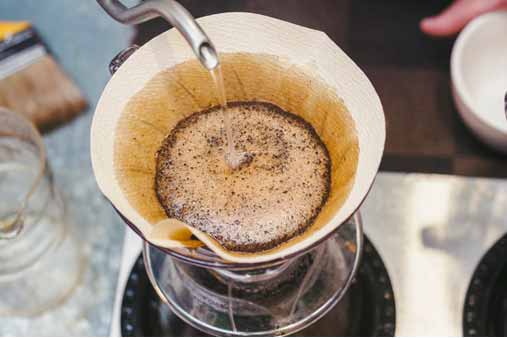How to Start a Specialty Coffee Shop
So you’ve decided to take your love of coffee out into the world, but where do you begin?
Written by coffee professionals, this guide will help you navigate the first steps you’ll need to take to make your dream cafe a reality.
Inspired by coffee professionals, our coffee shop business guides will steer you through the necessary steps to make your coffee dreams real, from picking a location to buying equipment, sourcing beans, hiring baristas, choosing a POS system, forming an actual company, and everything in between.

Steps to Start a Specialty Coffee Shop
Step 1: Find the Right Location
The first step in starting your own specialty coffee shop is deciding on a location. This informs all of the other decisions you will make, including what equipment to buy and even what products to serve.
Here are a few questions to consider as you evaluate potential locations:
- How will you connect with the local community? Coffee shops rely heavily on establishing regular customers and building a comfortable atmosphere for them. As such, it’s important to assess the area in which you plan to set up shop and appeal to that demographic.
- What kind of customer base do you aim to attract? The type of customer you serve will dictate the type of products you offer. For example, if you choose a downtown location, you will most likely sell large quantities of drip coffee. Therefore, a cafe that offers only pour-over coffee will not work well in that area. The opposite is true for a neighborhood location that most likely sees its busiest days on the weekends with patrons who want a special, slower experience.
- What’s your budget? Specialty coffee shops can succeed in many locations — even outside upscale neighborhoods. If you don’t have a huge budget, scout for space in areas with thriving standalone restaurants, bars, and shops.
- What’s your roasting plan? Finding space for a combined roasting facility and cafe is a completely different location search than for a standalone coffee shop. If you plan to roast your own coffee alongside your cafe, you must consider not only the physical space, but also any neighborhood concerns regarding smoke and sound emissions, access to power, and other necessities for your operation.
No matter what type of location you choose, marketing and social media can help you entice a broad range of customers to experience your cafe. Keep reading to learn how to use branding to drive traffic to your new location.
Step 2: Decide on Your Brand Strategy
Once you choose your location, the next thing to think about is your coffee shop’s branding. Do a little research on the neighborhood to better understand your customers and get a clearer view on what style and brand story will work best for your business.
Understanding your customers will help you pick the right vibe for your cafe and help you create a unique logo for your coffee shop. If you need help with designing your logo, try our Free Coffee Shop Logo maker to start branding your cafe quickly and easily. After you decide on your logo, next you’ll want to think about how to make your business stand out
Here are a few things to consider:
- Communicate your core values. When developing a brand for your shop, authenticity is the most important element. Allow your core values to inform your decisions when branding your shop and navigating trends.
- Highlight what sets you apart. Becoming a valuable member of any community requires you to bring something to the table. While it’s important to fit into the local culture, your shop also needs to offer something new or different that will make it stand out. Your shop’s point of differentiation could be the products you offer, an uncommon brew method, or even a unique build-out.
- Build buzz across multiple channels. That special thing that sets you apart may also be a crucial factor in encouraging people to spread the word about your shop. Either by word-of-mouth or through social media, you want people to leave your establishment with an experience they’re excited to share.
With a distinct brand for your coffee shop, you’re better equipped to show off your business’ cool products and amazing customer experience.
Step 3: Design an Optimal Floor Plan
If you’ve ever worked in a cafe, you already know the importance of a smart build-out. But how do you create an efficient, yet visually appealing workspace in your coffee shop? Consider these core elements as you plan your space:
- If you want to enable your baristas to talk with customers while making drinks, ensure the back of your machine faces the customer.
- If you want customers to be able to watch a barista make their drink, align the espresso machine so its side faces the customer. This will give them a full view of your skillful staff at work.
- If you bought a truly beautiful machine and want to show it off, position the front-facing the customers. Be aware, though, that this placement can decrease your baristas’ ability to engage with customers.
- Equipment Placement: Commercial coffee equipment is bulky. That means where you place your espresso machine will impact the relationship your baristas have with customers and how those customers engage with your product. For example:
- Counter Space: How you use the counter space in your shop often impacts the efficiency of your daily operations. Be sure to allocate room for the following items when planning your counter space:
- Food preparation and displays
- POS Systems
- Manual brew methods
- Grinders for both espresso and drip coffee
- Knock box
- Drip coffee maker
- Menus and a “specials” board
- Pick-up area for drinks
- Employee Workflow: A logical, efficient workflow should inform decision-making about your build-out. Consider each step a barista must take to complete an order and map out a path with the fewest steps possible. Where you place your milk fridge, espresso machine, coffee grinders, and pitcher rinser can either enhance or hinder the efficiency of your staff.
- Menus and the Ordering Process: When customers enter your shop, you want them to have an intuitive, stress-free experience. That requires careful planning as you develop your menu and decide where customers will place orders to ensure an efficient process.
- For example, if you have just one small menu in front of the register, customers won’t be able to consider their options before they reach the front of the line. That means they may face pressure from a barista to make a decision quickly.
- You also must clearly communicate where customers should place orders and if they must pick up their own drinks or if an employee will bring it to them.
To ensure your cafe operates smoothly, you need a floor plan and counter layout designed for efficiency. If you’re unsure about your setup, play around with a few different ideas by pretending to complete cafe tasks with your counters and floor cleared to see how it feels.
Step 4: Decide Whether or Not to Roast
Roasting your own coffee can make you a self-sustaining business owner with lower supply chain costs as you bypass the middleman for your key product. This approach also can help drive interest in your business before you even open your doors. Here are the main pros and cons to consider:
Pros:
- Establishing your own roastery (or using a communal roasting space) gives you an opportunity to promote your brand more broadly before opening your cafe.
- Supplying wholesale accounts that want to serve or carry your coffee can boost your income alongside your cafe.
Cons:
- Securing a roastery location is more difficult than finding space for a cafe due to concerns about sound, smoke, and other emissions associated with such a facility.
- Roasting coffee well requires a certain degree of skill. If you don’t already have this expertise, it can take several years — as well as several thousand dollars — to achieve the necessary education.
If you decide to roast your own coffee, you’ll need to source beans directly from a farm or, more commonly, from a coffee importer. Here are some key factors to consider:
Importer:
- Coffee importers are a common tool in the coffee industry. They are middlemen who source and distribute green (unroasted) coffee beans to roasters.
- The benefit of this approach is greater control and continuity over your product because importers are responsible for designating a profile for each coffee and guaranteeing quality. This is especially helpful because coffee beans vary drastically by lot and season.
- The main challenges of sourcing from an importer include lack of communication with the producers, order minimums, and higher prices.
- For an importer to transport the beans to their facility and then to a buyer, they most likely need to charge at least $4.50 per pound to make a profit.
Farmer:
- Coffee plants differ not only by country but also by region. Different regions also will produce different flavor profiles in coffee due to climate, soil, altitude, and the coffee process common to that area.
- Certain countries also have a reputation for specific flavor profiles, such as Ethiopia’s bright and fruit-forward coffees.
- The benefits of sourcing coffee directly from a farmer are lower initial cost and transparency with regard to fair trade practices.
- The main challenges of farm-direct sourcing include language barriers, transportation difficulties, and storage practices that can, at times, negatively impact the coffee’s quality.
- The necessary price a specialty coffee farmer should charge (just in green bean form) to pay employees a livable wage is around $3.75 per pound. This doesn’t include the cost to export the beans as well as potential taxes.
Processes:
Understanding the common coffee production processes is crucial when buying green coffee beans either from an importer or farmer. Why? Because each process affects the flavor profile of the beans differently, which will inform what you buy and how you roast them.
- Natural/Unwashed: Once the coffee cherries reach ideal ripeness, farmers pick them from the trees, place them on drying racks, and sun-dry them to fully remove the pulp and mucilage (the fruit surrounding the bean). This typically takes three to six weeks.
- Pulped-Natural/Honey: Farmers remove the skin of ripe coffee cherries, but leave the sticky mucilage and fleshy inside intact, before sun-drying them as in the natural/unwashed process above.
- Fully Washed: After picking ripe coffee cherries, farmers place them in a vat of water and skim off any that float to the top. Farmers then use large amounts of water to remove the pulp and mucilage from the remaining cherries, ferment the cleaned beans, and, finally, dry them.
Beyond flavor and desired region, there are many factors that go into choosing a farmer or importer, including company ethics, availability, cost, and the political climate in the countries growing the coffee.
Step 5: Choose a Coffee Supplier if You’re Not a Roaster
If roasting beans is not part of your business plan, you can buy coffee fairly easily and cost-efficiently from a wholesale roaster. In fact, many business models in the specialty coffee world now focus on producing a quality beverage vs. roasting the beans themselves. One major benefit of this approach is that you can feature different roasters and offer customers more variety because you don’t have to worry about selling a large amount of one specific type of coffee. This frees you to focus on cultivating the right environment for your customers vs. roasting coffee.
Here are a few things to consider when choosing your coffee supplier:
- Roast Types: It’s rare to find a dark or French roast in a speciality coffee shop. This doesn’t mean you shouldn’t carry them, but it does influence the type of supplier you choose. The most common roast in specialty coffee shops is a light roast because it allows the coffee’s flavor profile to shine through.
- Blends and Single Origins: Blends are pretty standard for a coffee shop’s main espresso because of their versatility in flavor and dependability. However, you can choose to use a single origin and/or feature single origins as an espresso option.
- Options: Be sure to understand not only the selection of coffees a coffee supplier offers (in terms of roast and origin), but also how frequently those options change.
- Terms of Wholesale: Many coffee suppliers reserve certain coffees for their own cafes. That means you may like a variety of a specific supplier’s beans, but only have access to a limited selection.
- Additional Perks: Ask about complimentary training and equipment because some suppliers will offer these to their wholesale customers.
Finally, if you serve a wholesale roaster’s coffee, consider selling their beans as well. This can boost sales, especially around weekends when customers may want to make coffee at home.
Step 6: Find Equipment for Your Cafe
Selecting the right equipment for your coffee shop is a major investment — second only to investing in the right location. Here’s a list of core equipment you’ll need:
- Espresso machine
- Espresso grinders (two or three total)
- Drip coffee maker
- Separate grinder for drip coffee
- Pitcher rinser
- Water filter
- Pitchers
- Measuring cups (two-ounce size)
- Tampers
- Scales for espresso, drip, and manual brew coffee
- Filters for drip and/or manual brew coffee
- Cups and saucers
- Scales
- Kettles
- Knock box
- POS system
Renting Your Equipment
When choosing equipment, be sure to consider all of your options. That includes whether to rent or buy. Here are several factors to consider as you evaluate which option is best for you:
- Monthly Payments: Some equipment rental firms include a product with their rental fees. This can reduce your monthly rental payment, depending on your order volume.
- Lower Upfront Costs: As a renter, you pay less upfront because you only pay an initial fee plus a monthly rental payment vs. covering the full cost of expensive equipment like an espresso machine. This can help small business owners with limited starting capital.
- Decreased Liability: Similar to the difference between owning or renting a home, renting equipment lowers your liability significantly. For example, you won’t be liable for damages if you experience some sort of issue with your rented drip coffee machine.
- Covered Machine Maintenance: Most rental companies provide maintenance with their machines. This means you avoid out-of-pocket expenses for unexpected issues as well as routine maintenance, such as updating parts.
- Greater Flexibility: If you decide your current equipment is not the right fit, you can adjust your rental contract to include different machines that better meet your evolving business needs.
Buying Your Equipment
- Limited Warranties: Manufacturers typically include at least a one-year warranty after you purchase their equipment.
- Resale Potential: You can usually recoup part of your original investment in an espresso machine by selling the used machine for a fraction of its original value to another coffee shop.
- Lower Long-Term Costs: If you don’t plan to order any supplies through your equipment rental company, you can achieve lower long-term costs by buying your own machines. Moreover, if you don’t like the type of coffee and other supplies offered by your equipment rental company, you’ll be better off sourcing your products elsewhere.
- Flexible Payment Plans: Some equipment manufacturers offer payment plans when you by their machines because large espresso machine can cost more than $6,000.
- Increased Liability: As the owner of your espresso machine and other equipment, you are responsible for all maintenance costs. To minimize those costs, you should keep up with routine maintenance by cleaning your espresso machine every night, backflushing it during the day, and replacing smaller parts yourself.
The equipment you choose must work well in your cafe so select the pieces you and your staff feel most comfortable using.
Step 7: Look into Manual-Brew Methods
Manual-brew methods are a common feature of specialty coffee shops. This can be just one type offered as a specialty item or a method that entirely replaces drip coffee at your shop.
The popularity of manual-brew methods stems from the clear flavor profile and special customer experience they produce. However, due to the labor-intensive nature of these methods, they can cause delays during peak rush times.
If you’re considering using a manual-brew method, here are a few options:
AeroPress
Efficient, inexpensive, easy cleanup
This brew method combines pressure and immersion to produce a clean taste. You can alter recipes to the specifications of your featured coffee.
Chemex
Recognizable, with a variety of sizes so you can produce a larger quantity of coffee than most manual brew methods
A popular pour-over brand since the 1940s, Chemex is easy to use and produces a clean cup of coffee that highlights the coffee’s specific flavor profile.
Kalita
Easy method for single-cup brewing; produces a quality cup of coffee
The Kalita Wave is another popular and recognizable pour-over method. This efficient and easy manual method produces one cup of coffee at a time.
French Press
Efficient, less labor-intensive than other pour-over methods, variety of sizes
French press is a classic and unique manual-brew method because it creates a rich coffee with a thicker mouthfeel than coffee produced by other methods. If desired, you can use it as an alternative to drip coffee.
Moka Pot
Produces a delicious, tiny cup of coffee
The Moka pot is definitely one of the lesser-used, manual-brew methods because it requires a stove or hot plate not usually found in cafes. However, it’s a great choice for cafes that lean toward European-style coffee methods.
Step 8: Choose Your Cafe's Flavors & Drink Enhancements
Deciding on the items that will complement your coffee is the next step in developing your new coffee shop.
Here are a few options to consider:
- Teas and Tea Lattes: Chai and/or matcha are the most common offerings.
- Flavored Syrups: Vanilla, chocolate, and caramel are the most popular flavors, although some cafes carry a wide variety.
- Milk and Milk Alternatives: At a minimum, you should carry whole milk, half-and-half, and nonfat milk. Finding a local dairy supplier as well as access to popular milk alternatives such as almond, soy, coconut, or oat milk is important.
Pro Tip: When choosing alternative milks, look for “Barista Series” versions with added protein to simplify steaming and microfoam production.
Step 9: Decide on What Foods & Pastries to Sell in Your Cafe
You’ve likely noticed that your favorite cafe offers an array of snacks for its customers. In specialty coffee shops, common snacks include pastries and other small items that pair well with coffee. However, some cafes now offer larger menus to accommodate customers seeking breakfast or lunch with their coffee.
As you decide what to include on your initial food menu, here are a few tips:
- Keep it simple. Choose food items that require little or no preparation — unless you plan to have a full kitchen.
- Offer variety. Gluten-free and vegan treats can not only set you apart from competitors but also entice different types of people to enjoy your cafe.
- Go local. Specialty coffee consumers often appreciate higher-quality snacks so find bakeries that locals love and start a wholesale account with them.
Step 10: Hire & Train Your Specialty Baristas
Think about your favorite coffee shop. What keeps you coming back? Or, more specifically, who? There is something about a positive interaction with a barista that makes a specialty coffee worth the extra money. Beyond the expertise needed to brew the perfect cup of coffee or pour a rosetta into a well-crafted shot of espresso, the ability to create a pleasant customer experience should be a major factor as you consider who to hire and train for your coffee shop.
Coffee knowledge is a great starting point to help you identify top candidates in the hiring process. This knowledge — paired with a passion for sharing it — creates a unique experience for customers that entices them to return again and again.


